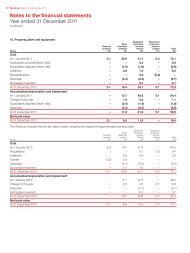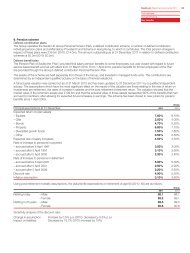Savills plc 2012 Annual Report - (PDF) - Investor relations
Savills plc 2012 Annual Report - (PDF) - Investor relations
Savills plc 2012 Annual Report - (PDF) - Investor relations
You also want an ePaper? Increase the reach of your titles
YUMPU automatically turns print PDFs into web optimized ePapers that Google loves.
Available-for-sale investmentsAvailable-for-sale investments are stated at fair value, withchanges in fair value being recognised in other comprehensiveincome. When such investments are disposed or becomeimpaired, the accumulated gains and losses, previouslyrecognised in other comprehensive income, are recognisedin the income statement.Trade receivablesTrade receivables are recognised initially at fair value andsubsequently measured at amortised cost less provision forimpairment. Receivables are discounted where the time valueof money is material.A provision for impairment of trade receivables is establishedwhen there is objective evidence that the Group will not be ableto collect all amounts due according to the original terms of thereceivables. Significant financial difficulties of the debtor,probability that the debtor will enter bankruptcy or financialreorganisation, and default or delinquency in payments areconsidered indicators that the trade receivable is impaired. Theamount of the provision is the difference between the asset’scarrying amount and the present value of estimated future cashflows, discounted at the original effective interest rate.The carrying amount of the asset is reduced through the use ofan allowance account, and the amount of the loss is recognisedin the income statement within ‘other operating expenses’. Whena trade receivable is uncollected, it is written off against theallowance account for trade receivables. Subsequent recoveriesof amounts previously written off are credited against ‘otheroperating expenses’ in the income statement.Cash and cash equivalentsCash and cash equivalents include cash in hand and depositsheld on call with banks, together with other short-term highly liquidinvestments with original maturities of three months or less andworking capital overdrafts, which are subject to an insignificantrisk of changes in value. Bank overdrafts are included underborrowings in the statement of financial position.Bank borrowingsInterest-bearing bank loans and overdrafts are initially measuredat fair value, net of transaction costs incurred, and subsequentlymeasured at amortised cost using the effective interestrate method.Trade payablesTrade payables are initially measured at fair value andsubsequently measured at amortised cost, using the effectiveinterest rate method. Trade payables are classified as currentliabilities if payment is due within one year or less. If not, they arepresented as non-current liabilities.Derivative financial instruments and hedgingDerivatives are initially recognised at fair value on the datea derivative contract is entered into and are subsequentlyremeasured at fair value. The method of recognising the resultinggain or loss depends on whether the derivative is designated as ahedging instrument and if so, the nature of the item being hedged.Certain derivatives do not qualify for hedge accounting. In thesecases, changes in the fair value of all derivative instruments arerecognised immediately in the income statement.Gains and losses relating to the effective portion of hedges ofnet investments in foreign operations are recognised in othercomprehensive income. Gains or losses relating to the ineffectiveportion are recognised immediately in the income statement.Gains and losses accumulated in equity are included in theincome statement when the foreign operation is partiallydisposed or sold.Share capitalOrdinary shares are classified as equity. Incremental costs directlyattributable to the issue of new shares or options are shown inequity as a deduction, net of tax, from the proceeds. When sharecapital is repurchased, the amount of consideration paid, includingdirectly attributable costs, is recognised as a charge to equity.Repurchased shares which are not cancelled, or sharespurchased for the Employee Benefit Trust, are classified astreasury shares and presented as a deduction from total equity.TaxationThe tax expense for the period comprises current and deferredtax. Tax is recognised in the income statement, except to theextent that it relates to items recognised in other comprehensiveincome or directly in equity. In this case, the tax is also recognisedin other comprehensive income or directly in equity.The current income tax charge is calculated on the basis of thetax laws enacted or substantively enacted at the balance sheetdate in the countries where the company and its subsidiariesoperate and generate taxable income. Management periodicallyevaluates positions taken in tax returns with respect to situationsin which applicable tax regulation is subject to interpretation. Itestablishes provisions where appropriate on the basis of amountsexpected to be paid to the tax authorities.Deferred income tax is recognised, using the liability method, ontemporary differences arising between the tax bases of assetsand liabilities and their carrying amounts in the consolidatedfinancial statements. However, deferred tax liabilities are notrecognised if they arise from the initial recognition of goodwill;deferred income tax is not accounted for if it arises from the initialrecognition of an asset or liability in a transaction other than abusiness combination that at the time of the transaction affectsneither accounting nor taxable profit or loss. Deferred income taxis determined using tax rates (and laws) that have been enacted orsubstantially enacted by the balance sheet date and are expectedto apply when the related deferred income tax asset is realised orthe deferred income tax liability is settled.Deferred income tax assets are recognised only to the extent thatit is probable that future taxable profit will be available againstwhich the temporary differences can be utilised.Deferred income tax is provided on temporary differences arisingon investments in subsidiaries and associates except for deferredincome tax liability where the timing of the reversal of he temporarydifference is controlled by the group and it is probable that thetemporary difference will not reverse in the foreseeable future.Our business Our governance Our results<strong>Savills</strong> <strong>plc</strong> <strong>Report</strong> and Accounts <strong>2012</strong> 69
















